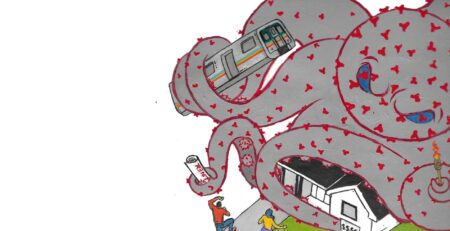This is custom heading element
[post-fields post_field=”wpcf-subtitle”]
[post-fields post_field=”wpcf-byline”]
After years of steady decline, cigarette sales in the U.S. rose last year for the first time in 20 years — in large part because of the pandemic, says Lucy Popova, associate professor in the School of Public Health who serves on the U.S. Food and Drug Administration’s Tobacco Products Scientific Advisory Committee. New research led by Popova examines how the pandemic and related stressors impacted tobacco users’ habits. In the study, many smokers admitted to lighting up more often despite the health risks, including the possibility of severe lung impacts from COVID-19.
“The purpose of the study was not to find the population trends but to get insight into people’s personal experiences,” says Popova. “We wanted to learn how COVID and related stresses and changes in people’s lives affected them, and how that all translated into their tobacco use.”
Your study sheds light on how the pandemic has affected a specific group of Americans: Smokers. Can you talk about what you learned?
We did a qualitative study with 61 tobacco users, which is not a large sample, but it does offer a window into people’s experiences. We looked at three different groups of smokers. Two of those groups were not thinking about quitting: those who only smoke cigarettes but don’t use e-cigarettes, and those who use e-cigarettes exclusively or in addition to regular cigarettes (these are known as “dual users”). A third group of people had quit smoking or quit using e-cigarettes since the start pandemic or were trying to quit. We separated participants in those categories because we thought they might have different views and experiences.
We did find differences in terms of how people thought COVID-19 affected their habits, whether they believed quitting would be a good thing and whether they had tried to quit during the pandemic. There were also some similarities among these three groups. Most everybody was stressed out and bored. And overall, people were smoking more. That was really the predominant pattern we saw.
Why do you think that is?
Some people did cut down. These were mostly the social smokers. They would usually smoke in bars or when hanging out with friends, and during lockdowns especially many people’s social lives were upended. On the flip side, other people smoked more because they were working from home, and they didn’t have workplace restrictions on smoking or stigma associated with smoking at their workplace.
Again and again, we heard that people feel like just taking a few minutes off with a cigarette helps them cut down on boredom. As one respondent said, “There’s only so much cleaning you can do, and you can only talk to your dogs for so long.” Smoking becomes a distraction.
Or they consider smoking to be a way of coping with the added stress of the pandemic.
Right. Particularly among the people who were exclusive smokers, many weren’t interested in quitting. They were saying “Well, this is not the time to quit.” They see that as adding another stressor in their life.
For many Americans, the pandemic was a wake-up call about their health. Did that provide some smokers with extra motivation to quit?
For many of our participants, when COVID came around it was another impetus to quit. On the other hand, these same respondents were stressed and maybe they were spending time with family members who smoke. We heard about a lot of tension and struggle where smokers know they need to quit, but they just can’t right now.
Other people tried to rationalize their decision to continue smoking. We even heard some people say they believed smoking might be protective against COVID, although the evidence is solid now that smoking exacerbates the severity of the disease.
What do your findings reveal about how to convince smokers to quit or help support smokers who want to quit?
As researchers and public health practitioners, our goal should be to remind people of the reasons to quit and then provide them with resources to deal with the negative stuff — particularly stress — in more constructive ways. A lot of smokers are low income and have lower levels of education, so making sure there is a social safety net in place for them and providing mechanisms to help deal with stressors is an important step.
We also need to consider how to counter the assumptions that people have about smoking. For example, most smokers know that quitting smoking will help with lung health and susceptibility to COVID complications. But it’s also important to explain that quitting will actually help reduce stress. A lot of smokers view smoking as a stress reliever, but we know that once you quit, your stress levels actually go down.
What’s your message to smokers who are thinking about quitting?
The biggest predictor of quitting success is simply how many times you have tried. For people who are struggling out there, just try again and again. Sooner or later, you will succeed as many others did before you. Today we have more former smokers than current smokers!
I also think the pandemic can be used as a teachable moment to make smokers more aware of the ways that smoking harms the body, particularly in situations where there are other dangers in the environment. There are so many resources out there to help smokers to quit and it’s important to figure out how to deal with stressors in more constructive ways.
For free help in quitting smoking, call 1-800-QUIT-NOW or visit smokefree.gov.
Portrait by Steven Thackston












Leave a Reply